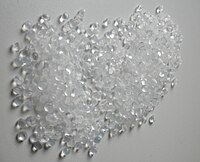
Photo from wikipedia
The preparation and investigation of a free-standing membrane made from a composite of thermoresponsive poly(N-isopropylacrylamide) (pNIPAAm) and polystyrene nanoparticles (PS NP) with temperature-controlled permeability is reported. The method exploits the… Click to show full abstract
The preparation and investigation of a free-standing membrane made from a composite of thermoresponsive poly(N-isopropylacrylamide) (pNIPAAm) and polystyrene nanoparticles (PS NP) with temperature-controlled permeability is reported. The method exploits the light-induced crosslinking of the photo-reactive pNIPAAm-based polymer and mechanical reinforcement of the membrane structure by the polystyrene nanoparticles. About micrometer thick layers were either directly attached to a gold surface or prepared as free-standing layers spanning over arrays of microfluidic channels with a width of about hundred microns by using template stripping. Diffusion of liquid medium, low molecular weight molecules, and large molecular weight proteins contained in blood through the composite membrane was observed with combined surface plasmon resonance (SPR) and optical waveguide spectroscopy (OWS). The swelling ratio, permeability, and nonspecific sorption to these composite membranes were investigated by SPR and OWS as a function of molecular weight of analyte, loading of PS NP in the composite film, and temperature. The authors show successful preparation of a defect-free membrane structure that acts as a thermoresponsive filter with nanoscale pores spanning over an area of several square millimeters. This membrane can be reversibly switched to block or allow the diffusion of low mass molecules to the sensor surface by temperature-triggered swelling and collapsing of the hydrogel component. Blocking of diffusion and low unspecific sorption of proteins contained in blood serum is observed. These features make this platform interesting for potential future applications in continuous monitoring biosensors for the analysis of low molecular weight drug analytes or for advanced cell-on-chip microfluidic studies.
Journal Title: Biointerphases
Year Published: 2017
Link to full text (if available)
Share on Social Media: Sign Up to like & get
recommendations!